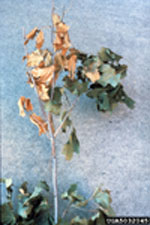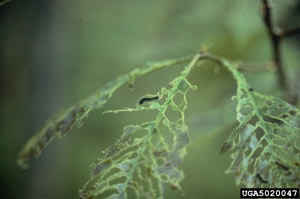TREE TALK
Originally published in Capital on June 19, 2008

When Trees Die
They fight to survive until the very end...
So far we’ve had more than ample rain to support good fruit
development and shoot growth, so for the first time in a few years, growth
should be normal or even better than normal for most trees. The extra rain we’ve
had and the somewhat cool spring (up until the last week or so at least when it
shifted directly to late summer, temporarily I hope) has caused havoc with
foliar diseases such as Sycamore anthracnose and apple scab. Trees usually
recover from those though so it’s not cause for excessive alarm. What is
noticeable right now are those trees that aren’t doing so well due to a variety
of reasons.
When a tree dies very quickly, over say a few weeks, then it’s time to look for
signs of a virulent pathogen like a fungal disease that affects the conductive
tissue. The conductive tissue of a woody plant is composed of the xylem cells
that conduct water from the roots, also know as the sapwood; xylem cells, both
the 'dead' or inactive xylem cells and the living, active cells collectively
form the 'wood' in a woody plant. The other type of conducting tissue is the
phloem, 'the inner bark' that conducts the nutrients and organic compounds
necessary for the growth and function of the tree.
Verticillium wilt caused by the fungus Verticillium albo-atrum is a fungal
disease of the sapwood that quickly clogs these xylem cells that conduct the
water throughout the tree. This disease which is commonly found on maples, elms,
oaks, and catalpa, to name a few, can sometimes kill a small tree in days. The
fungus also attacks herbaceous plants also, The fungus spends it’s time when not
causing havoc as a sapotrophic organism, living on dead organic matter in the
soil where it can persist up to fifteen years.
There are few truly quick tree pathogens, and when you
think about it, a pathogen that kills its host quickly puts itself at a
disadvantage because it would need to be able spread very quickly to maintain
its spread within the population
Quick death for a tree is the exception though, because trees don’t give up
easily. They fight to survive until the very end. If you remove one or more of
these three basic requirements for a tree - water, light and nutrients - death is
of course certain. Complete removal of one of these requirements is usually a
gradual thing so the death for a tree is usually gradual as well. A tree may be
shaded by other trees through competition, a building might have been placed next
to it or even another tree planted there shading it.
Moisture maybe restricted
by a lot of reasons. There may be a drought, a change in the hydrologic pattern,
or (and this is common in urban areas) damage to the root system from construction
or soil compaction from vehicles or foot traffic, thereby cutting off sufficient
moisture and oxygen for the roots, Lastly there just might be not enough
nutrients to go around, because there are too many trees, or other plants (think
turf grass, Kudzu or Japanese honeysuckle) competing for those nutrients.
No matter the causes, and there are usually several acting in concert, as trees
start to die they go into a defensive mode; they ‘pull’ back by jettisoning
branches especially when it’s a matter of insufficient light. This tends to
occur on the lower branches farthest from the light. If water and or nutrients
are the 'root' cause' (pun intended), the outer ends of the branch (the part
farthest way from the roots) will start to die, as it's harder to get water and
nutrients to them. Another symptom of a tree in distress is when a tree
will flush out smaller leaves as it doesn't have the resource to produce full
size leaves, but is none the less unwilling to give up.
 Another way trees can die is through starvation that can be attributed to
defoliation. The Gypsy moth is one of the prime culprits in this scenario. The
Gypsy moths kill trees by consuming the leaves of the tree. On evergreen trees,
which are not their preferred hosts, it's usually one and done. On hardwood
trees one occurrence usually doesn't kill it outright, unless the tree is weak
from other factors to begin with. Once defoliated, the tree will flush out
another set of leaves and take up where it left off.
Another way trees can die is through starvation that can be attributed to
defoliation. The Gypsy moth is one of the prime culprits in this scenario. The
Gypsy moths kill trees by consuming the leaves of the tree. On evergreen trees,
which are not their preferred hosts, it's usually one and done. On hardwood
trees one occurrence usually doesn't kill it outright, unless the tree is weak
from other factors to begin with. Once defoliated, the tree will flush out
another set of leaves and take up where it left off.
However, if this is repeated over several years, the tree will use up food reserves which it cannot easily replace, and the tree will start to weaken and it will die. Well spaced trees on moist and fertile sites will have a better time withstanding the onslaught of the gypsy moth than a tree growing on poor soil or in a dense stand where competition is fierce to begin with. Gypsy moth damage is quite noticeable right now in some areas. These pockets of defoliated or dead trees indicate the poor sites or areas where the Gypsy moth has been active for several years.
It is important therefore to keep an eye on the condition of
tiny trees you are concerned about. Look for signs of numerous dying branches,
or branches dead at the tips. And of course keep an eye out for pests like the
Gypsy moth; they are sneaky and can quietly turn into a major crisis in the
blink of an eye.
Questions and comments can be directed to
ForestGreenway@comcast.net
Bud Reaves writes Tree Talk for the Anne Arundel County Forest Conservancy
District Board.
Photo of symptom of
Verticillium wilt courtesy of
Joseph O'Brien, USDA Forest Service, United States
Photo of Gypsy moth damage, courtesy of Pennsylvania Department of Conservation and Natural Resources - Forestry Archive, Bugwood.org
"TREE TALK" ArchivesAdditional Forestry-Related Links
Champion Trees of Anne Arundel County
Big Tree Champions of Maryland
Native Plants for Anne Arundel County
Planting and Care of Your Trees
TREE-MENDOUS MARYLAND
Invasive Species